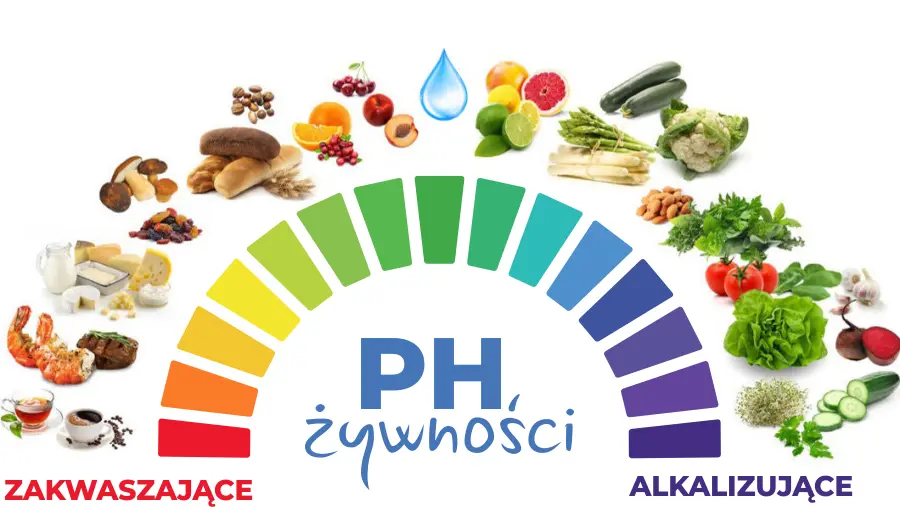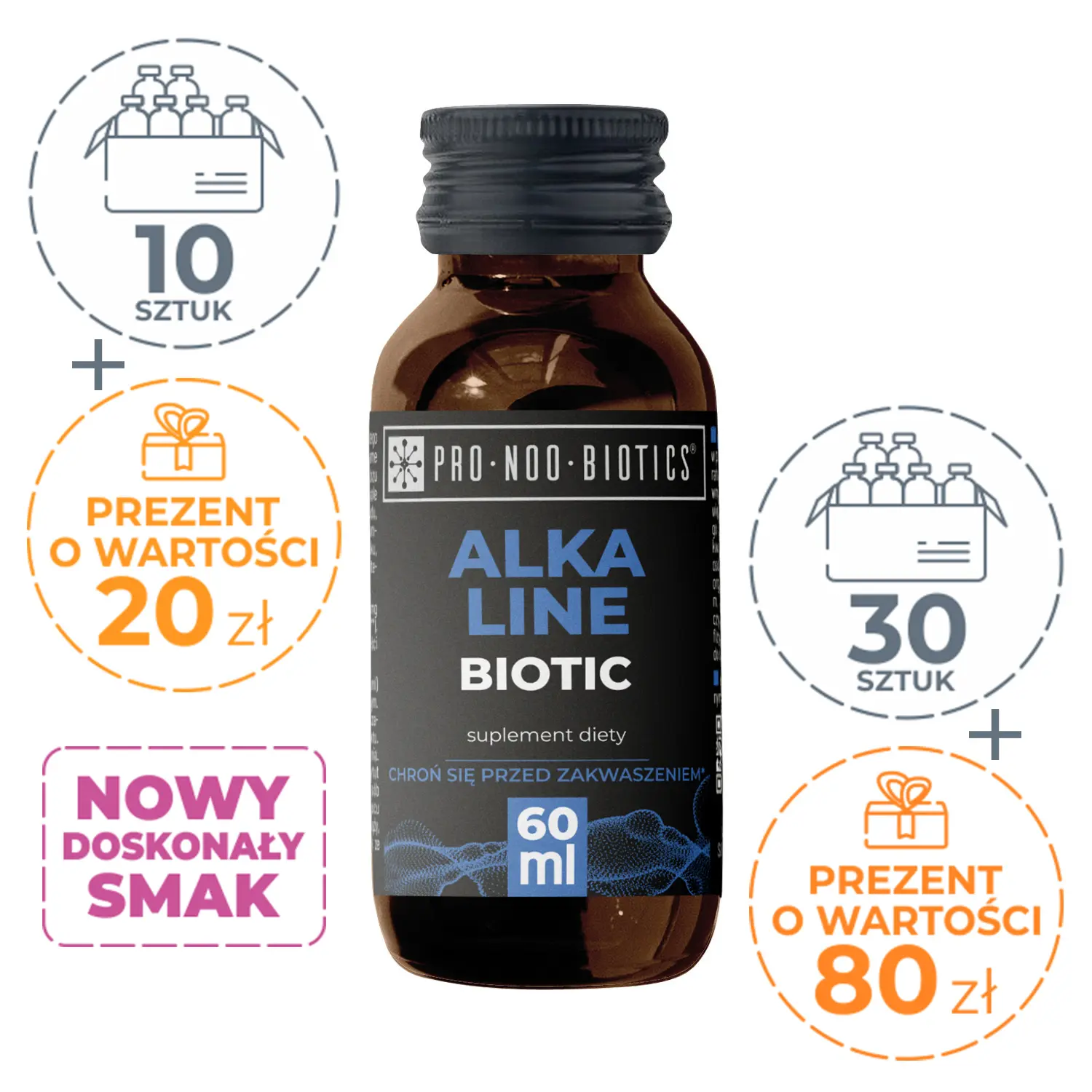Calcium builds bone tissue, influences the proper functioning of the body's electrolyte balance and...
Make sure your body is NOT acidified
Alkaline Biotic
Flavor: Joyful mint
Rated 5.00 out of 5 based on 1 customer rating
Categories: HumaBiotics®, Stop acidification
- "JUST 6 SHOTS DO WONDERS - I'M BEAUTIFUL AND YOUNG AGAIN".
Od 11.99 zł
*GUARANTEE OF PRICE CONSTANCY
ALKALINE BIOTIC A dietary supplement in liquid form. Contains a sweetener (stevia). Provides, among other things, zinc, which helps maintain normal acid-base balance.
Intended for people aiming to reduce acidification of the body, caused by consumption of acidifying products (including meat products, coffee, sweets, alcohol), living under constant psychophysical stress, and especially athletes, aiming to shorten the post-workout recovery period.
Excessive acidification of the body is a condition that impairs the functioning of all systems.
When there are insufficient amounts of alkaline compounds, the body is forced to borrow them from the resources of important organs in order to buffer (neutralize) the acid, or more precisely, H⁺ ions and safely remove them from the body. Their rich reservoir is, for example, the bones.
As a result, the body can be vulnerable due to long-term losses of minerals such as calcium, sodium, potassium and magnesium.
Long-term acidification of the body can lead to acidosis, which in turn can lead to serious future problems with major organs such as the liver, heart or kidneys.
Acidosis can result in rheumatoid arthritis, type 2 diabetes, atherosclerosis, hypertension, osteoporosis, endocrine disruption, lupus, tuberculosis and other health problems, among others.
*RWS - reference intake value.
Recommended daily serving: Consume the contents of the ampoule (60 ml) once a day before bedtime or immediately after exercise. Shake before use. Sediment and crystallization that may appear are natural phenomena and do not affect the quality of the product. Do not exceed the portion recommended for consumption during the day. The dietary supplement should not be used as a substitute for a varied diet. A balanced diet and healthy lifestyle are recommended. Keep out of reach of small children.
Attention: Not recommended in pregnancy, breastfeeding or with hypersensitivity to any of the ingredients of the
of the product.
Storage conditions: In a dark, cool place; at room temperature.
Net volume: 60ml

COMPOSITION AND DOSAGE
Ingredients: 33% infusion of gout (Aegopodium podagraria L.), 33% an infusion of Arame seaweed (Eisenia bicyclis (Kjellman) Setchell), water, calcium salts of orthophosphoric acid, magnesium salts of citric acid, potassium carbonate, sodium carbonate, 0.3% kombucha (water, sugar, black tea, kombucha probiotic microorganism complex), calcium salts of citric acid, zinc carbonate, sweetener steviol glycosides from stevia.| Nutritional information | 60 ml |
|---|---|
| Calcium | 436 mg (54.5%*) |
| Phosphorus | 426 mg (60.9%*) |
| Magnesium | 95 mg (25.3%*) |
| Sodium | 87 mg |
| Zinc | 6.8 mg (68%*) |
Initial signs of acidification include:
- Feelings of weakness, fatigue and low energy levels
- Reddened blue eyes, bluish skin
- The smell of acetone from the mouth
- Experiencing anxiety, panic attacks and depression
- Skin problems such as eczema, psoriasis, acne and urticaria
- Heartburn
- Constant feeling of drowsiness
- Concentration problems
- Increased appetite for sweets
- Reduced libido
The signs of long-term acidification are much more serious and can lead to:
- Osteoporosis
- Weakening of the immune system
- Chronic digestive problems
- Arthritis, joint and ligament problems
- Accumulation of kidney stones, kidney disease and gout
- Heart and circulation problems
- Fungal and bacterial infections
Factors that compound the risk of acidification:
- Improper diet:
-
-
- excess protein and carbohydrates
- Insufficient amount of fruits and vegetables
- A diet rich in highly acidic products
- "Western" diet (rich in protein, poor in vegetables and fruits)
-
- Emotional stress
- Drugs (e.g., alcohol, cigarettes, coffee)
- Immune reactions
- Any process that deprives cells of oxygen (such as heavy workouts)
Foods and drinks with high acid-forming potential
- Meat, including poultry and fish
- Eggs
- Cheese
- Cereal grains
- Alcohol
Foods or beverages with high alkalinizing potential (NEEDED!):
- Vegetables
- Fruits
- Nuts
- Legumes
- Alkaline water

Acidification vs metabolic acidosis MIT or TRUE?
On the Internet you can find a lot of information, discussion and discussion about acidification - is it a myth or the truth...?- It is true that there are acid-forming and alkaline-forming foods. Acid-forming ones are mainly meat, yellow cheese, cereals or eggs, while alkaline-forming ones include vegetables and fruits.
- It is true that through intensive exercise we create an acid-base imbalance when we accumulate really a lot of hydrogen ions and lactic acid from anaerobic glycolysis in the body; colloquially, we talk about acidification of the body.
- It is true that the body has natural buffering mechanisms, that is, mechanisms that regulate and try to maintain a constant concentration of hydrogen ions, and thus keep the body in homeostasis.
- It is true that the overall good health of the body is influenced by many factors not just one workout, one acid-forming product, but the overall habits of life. The patterns you repeat every day are important. Since the average human diet is slightly acid-forming, the body can handle neutralizing it. However, what if you add heavy physical activity and post-workout another acid-forming meal, and perhaps consume some additional alcohol on the weekend...?
What is most commonly used to enhance buffer systems?
Alkaline phosphoric acid salts are involved in securing constant intracellular environmental conditions. In turn, the alkaline salts of citric acid and sodium bicarbonate are involved in supporting the work of the most efficient buffering substances of the circulatory system. According to a controlled study published in 2019, sodium bicarbonate is not only safe for people with kidney disease, but can also improve kidney function and quality of life for those struggling. It is therefore an essential buffer of blood and extracellular fluids. Care should be taken not to administer (in excess) sodium bicarbonate alone, the absorption and metabolization of which can bring a number of inconveniences such as:- nausea,
- bloating,
- abdominal pains,
- vomiting,
- swelling.
Who is affected by metabolic acidosis?
As we age, we become more acidic because our buffering systems no longer work as efficiently. The body of most elderly people is heavily laden with toxic waste in the bloodstream, cells and lymphatic system. Acidosis usually develops as a result of a number of environmental and lifestyle factors. If there is too much acid in the blood, which is removed by bicarbonate, and a person loses too much of it, for example, as a result of disease or kidney failure, our natural buffering systems are unable to neutralize the intracellular environment and the body's homeostasis is disrupted. Metabolic acidosis can affect anyone. However, it often affects people with kidney failure or chronic kidney disease. The body must have a certain pH balance in order to function properly. The pH scale determines the concentration of hydrogen ions in solutions. It ranges from 0 (very acidic) to 14 (very alkaline). Your blood's normal pH range is 7.35 to 7.45, which is slightly alkaline. The kidneys and lungs help maintain the proper pH balance. The kidneys remove excess hydrogen ions with urine and "recover" and also restore bicarbonate ions. The lungs regulate the amount of carbon dioxide in the blood. Metabolic acidosis can occur for several reasons - for example, the body produces too much acid or its supply is too high, also in the case of impaired bicarbonate regeneration by the kidneys or impaired bicarbonate excretion, or in the case of loss of alkaline compounds by the kidneys or from the gastrointestinal tract (e.g., diarrhea, internal fistulas).What are the symptoms of metabolic acidosis?
If you have metabolic acidosis, there may be no signs or symptoms. However, typical signs of it include:- Accelerated heartbeat (tachycardia)
- Confusion or dizziness
- A feeling of severe fatigue
- Loss of appetite
- Headache
- Rapid breathing (so-called Kussmaul's breath resembling that of a chased dog - fast deep breaths) or long, deep breaths
- Nausea and vomiting
- Feeling weak, tired, or feeling easily fatigued
- Breath with a sweet or fruity smell
What causes metabolic acidosis?
The four main causes of metabolic acidosis are:Acidosis associated with diabetes
It develops when ketone bodies build up in the body as a result of untreated diabetes. Your body produces ketone bodies while it converts (metabolizes) fats into energy. The body uses ketone bodies as a source of energy when sugars (glucose) are not available; however, their utilization is impaired in diabetes.Lactic acidosis
It develops when you have too much lactic acid in your body. Lactic acid is an organic acid that muscle cells and red blood cells produce for energy when there is not much oxygen in the body. Causes include liver failure, low blood sugar, alcohol use disorders or intense exercise.Hyperchloremic acidosis
It develops when the body loses too much sodium bicarbonate. This can happen if you take too many laxatives or have severe diarrhea.Renal tubular acidosis
It develops when the kidneys don't remove enough acid into the urine. As a result, your blood becomes more acidic.BIBLIOGRAPHY
1 Pirahanchi Y, Yesu R, Aeddula NR. Physiology, Sodium Potassium Pump. In 2020. 2. Liu X, Yang W, Guan Z, Yu W, Fan B, Xu N, et al. There are only four basic modes of cell death, although there are many ad-hoc variants adapted to different situations. Cell Biosci 3 SF. G. Developmental Biology. 6th edition. 2000. 4 Bogdanov A, Bogdanov A, Chubenko V, Volkov N, Moiseenko F, Moiseyenko V. Tumor acidity: From hallmark of cancer to target of treatment 5 Lee S-H, Griffiths JR. How and Why Are Cancers Acidic? Carbonic Anhydrase IX and the Homeostatic Control of Tumour Extracellular pH. Cancers (Basel). 2020 Jun;12(6). 6 Tobey JA. The Question of Acid and Alkali Forming Foods. Am J Public Health Nations Health. 1936 Nov;26(11):1113-6. 7 Remer T, Manz F. Potential renal acid load of foods and its influence on urine pH. J Am Diet Assoc. 1995 Jul;95(7):791-7. 8 Arora N, Jefferson JA. Metabolic Acidosis. In: Papadakis MA, McPhee SJ, Rabow MW, McQuaid KR, editors. Current Medical Diagnosis & Treatment 2022 9 Bargman JM, Skorecki KL. Chronic Kidney Disease. In: Jameson JL, Fauci AS, Kasper DL, Hauser SL, Longo DL, Loscalzo J, editors. Harrison's Principles of Internal Medicine 10. di Iorio BR, Bellasi A, Raphael KL, Santoro D, Aucella F, Garofano L, et al. Treatment of metabolic acidosis with sodium bicarbonate delays progression of chronic kidney disease: the UBI Study. J Nephrol 11 Adeva-Andany MM, Fernández-Fernández C, Mouriño-Bayolo D, Castro-Quintela E, Domínguez-Montero A. Sodium bicarbonate therapy in patients with metabolic acidosis.BEAUTIFUL SKIN AND FULL OF ENERGY
It plays an important role in maintaining the body's acid-base balance and energy production in...
Magnesium contributes to the maintenance of normal electrolyte balance. It is an alkaline-forming element.
By regulating water and electrolyte balance, it is a key ingredient in maintaining the body's homeostasis.
Podagrass has powerful alkaline, cleansing and detoxifying properties, making it...
Arame seaweed contains a large amount of easily digestible protein, minerals and vitamins. They act...
Exit grid
| Nutritional information | 60 ml |
|---|---|
| Calcium | 436 mg (54.5%*) |
| Phosphorus | 426 mg (60.9%*) |
| Magnesium | 95 mg (25.3%*) |
| Sodium | 87 mg |
| Zinc | 6.8 mg (68%*) |
*RWS - reference intake value.
Ingredients
33% infusion of gout leaves (Aegopodium podagraria L.), 33% infusion of Arame seaweed (Eisenia bicyclis (Kjellman) Setchell, elderberry juice NFC 20%, water, calcium salts of orthophosphoric acid, magnesium salts of citric acid, potassium carbonate, sodium carbonate, 0.3% kombucha (water, sugar, black tea, kombucha cultures), calcium salts of citric acid, zinc carbonate, natural mint flavor, sweetener - steviol glycosides from stevia.
BEFORE USE
APPLICATION
Designed for people striving to reduce the acidification of the body, caused by the consumption of acidifying products (including meat products, coffee, sweets, alcohol), living under constant psychophysical stress, and especially athletes, aiming to shorten the period of post-workout recovery.
RECOMMENDED DAILY ALLOWANCE
Consume the contents of the ampoule (60 ml) once a day before bed or immediately after exercise.
STORAGE
In a dark, cool place; at room temperature.
ADDITIONAL COMMENTS
Shake before use. Sediment and crystallization that may appear are natural phenomena and do not affect the quality of the product. Do not exceed the portion recommended for consumption during the day. The dietary supplement should not be used as a substitute for a varied diet. A balanced diet and healthy lifestyle are recommended. Keep out of reach of small children. Not recommended during pregnancy, breastfeeding or in case of hypersensitivity to any of the product ingredients.
1 review for Alkaline Biotic
Only logged in customers who have purchased this product may leave a review.















Arnold K. (Verified customer) -
Helpful